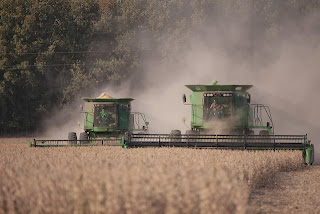Protect Your Health When It’s Dusty
Dusty combining conditions have been observed and reported during the last couple weeks of soybean (and corn) harvest in Wisconsin. Combine operators are far better protected with modern cab air filtration and handling systems than in the past, but dusty conditions still present health concerns for some.
Outside of a combine’s cab, most research shows that dust concentrations are at least 20 mg/m3 though I would estimate that some of the conditions I’ve seen in the last week would have had concentrations at least two or three times that level. Fortunately, a well-sealed cab and a quality air filter (filtering air coming into the cab) will reduce dust levels down to 0.5 to 1 mg/m3 which is much more comfortable and healthy for the operator.
Field dust from soybeans, corn, and other field crops is complex. It consists of inorganic soil particles, organic plant pieces, mold spores, insect parts (and excreta), endotoxins, and bacteria. Smaller dust particles can be breathed deep into the lungs and can cause damage.
 |
Respiratory illness from grain and other agricultural dust exposure is well-known to physicians in rural areas and can include severe allergic reactions and a reaction known as “organic dust toxic syndrome” (or ODTS). Nearly everyone exposed to a day’s worth of dusty conditions will report some range of symptoms such as a runny nose, mild sore throat, coughing, and general feelings of tightness or feeling stuffed-up. Some people develop different forms of bronchitis and dusty conditions can be debilitating for people with asthma.
Here are a few important things you can do to protect your health while operating a combine:
- Make sure you have the correct air filter in place and that it’s clean and properly installed. Several manufacturers sell heavy duty filters which are more efficient and will filter out a larger fraction of small particles. These are more expensive, but may be worth it if you have sensitivity to dust.
- When installing/cleaning your air filter, make sure gaskets are snug and in place. If you pull a filter out to clean it, make sure not to damage it (such as using too high of a compressed air pressure). Likewise, make sure your cab door latches firmly and that all rubber gaskets around windows and doors are in good shape. Keep the inside of the cab as clean as possible so you’re not blowing dust around your operating space.
- Even if you’re not driving the combine, do as much as possible to avoid clouds of dust. If you’re driving a truck or tractor/wagon combination, take the same precautions making sure to have windows shut and the fan on to create positive pressure to keep dust out.
- If you feel the effects of dust exposure and symptoms do not go away a day or two after exposure OR if they become worse (coughing, difficulty breathing, increasing amounts of phlegm, etc.) make sure to see a doctor or other qualified health professional. Realize that people can become more and more sensitive with repeated exposures to grain dust, so it’s wise to take steps to protect yourself.
Article from:
John M. Shutske, PhD
Associate Dean and Program Director
Agriculture and Natural Resources Extension & Outreach
College of Agricultural and Life Sciences
University of Wisconsin – Madison


Leave a Reply
Want to join the discussion?Feel free to contribute!